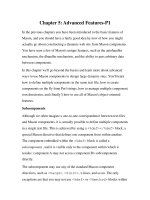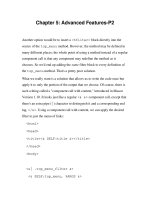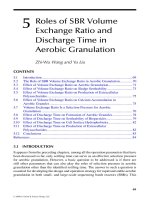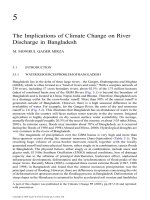Chapter 5 geochemical zoning in metamorphic minerals
Bạn đang xem bản rút gọn của tài liệu. Xem và tải ngay bản đầy đủ của tài liệu tại đây (7.54 MB, 28 trang )
Chapter 5. Geochemical Zoning
in Metamorphic Minerals
1. Introduction
2. Major element zoning: e.g. Garnet
(a) growth zoning; (b) diffusion zoning.
3. Trace element zoning: e.g. Garnet
(a) growth zoning; (b) exception case.
4. Isotope zoning:
(a) Oxygen isotope; (b) Radiogenic isotope
5. Summary
Introduction
● Most common
mineral: garnet
● Metamorphic
P-T history:
1 Progressive P-T
path
2 Retrograde P-T
path
Table 1 Examples of metamorphic minerals
that display chemical zoning† (Spear, 1993)
Major element zoning: Garnet
Common end members:
● Pyrope Mg3Al2Si3O12
● Almandine Fe3Al2Si3O12
● Spessartine Mn3Al2Si3O12
● Andradite Ca3Fe2Si3O12
(a)Typical growth zoning:
● Mn+/-Ca-rich core
● Mg increases towards rim
● Fractionation process
● Temperature < ~650 °C
Fig. 1. Prograde growth zoning in a garnet
from a lower-grade part of High Himalaya,
Ref: Waters webpage.
(b) Typical diffusion
zoning:
Fig. 2. Retrograde diffusion zoning in a
garnet from a high-grade part of High
Himalaya,
Ref: Waters webpage.
● Pre-existing garnet
changes composition
via diffusion
● Mg decreases and
Mn enriches towards
rim
● More extensive in
high-grade rocks
● Temperature >
~600 °C
Fig. 3a. X-ray maps showing the
distribution of elements in a garnet
from SW New Hampshire, USA.
Dark areas are low and light areas
are high concentrations.
Fig. 3b. Line traverse along line shown
in the Fig. 3a, showing the variation of
elements in a 1-dimentional traverse.
Ref: Spear, 1993. Metamorphic phase
equilibria and P-T-t path.
Retrograde diffusive exchange and reaction: e.g. garnet.
Fig. 4. Diagrams illustrating the change in Fe/(Fe+Mg) for garnet
and biotite during retrograde reactions (Spear, 1993; Kohn & Spear,
2000). G1-B1 shows peak metamorphic compositions, while G2-B2
and G2-B3 are retrograde compositions. T0 is metamorphic peak,
t∞ is final zoning profile.
Two types of reactions related to diffusion zoning:
1. Exchange reactions (ERs): only involve the exchange of two elements
between two minerals and do not affect the mineral modes,
e.g. Fe-Mg exchange between garnet and biotite:
almandine+phlogopite=annite+pyrope.
2. Net transfer reactions (NTRs): involve production and consumption of
minerals, which affect modal proportions, e.g.
garnet+K-feldspar+H2O=sillimanite+biotite+quartz.
Diffusion to the interpretation of geothermometry in high-grade rocks:
@ Equilibrium compositions are meaningful in thermometry calculation and
may obtain real metamorphic peak P-T conditions in high-grade rocks.
@ Disequilibrium compositions resulting from chemical zoning may produce
apparent or lower temperatures than real peak values.
e.g. in Fig. 4, G1-B1 garnet-biotite composition pairs normally yield peak
metamorphic conditions, whereas G1-B2 composition pairs are not in
equilibrium and usually produce lower values.
Fig. 5. X-ray element maps of Darondi section garnets with plagioclases.
GHS, Great Himalayan Sequence, LHS, Lesser Himalayan Sequence.
GHS: unzoned garnet core – high-T difussive homogenization.
rimward Mn increase – retrograde diffusion during cooling.
LHS: general Mn decrease – growth zoning with increasing T, some Mn
sharp increase at rim means back diffusion
after maximum T.
Ref: Kohn etc, 2001. Geology, 29, 571-574.
Monazite age:
10-22 Ma
Monazite age:
8-9 Ma
Fig. 6. Pressure vs. temperature plots for rocks along Darondi River
traverse. A. Main Central thrust (MCT) zone, P-T conditions increase
toward GHS. B. Structurally higher rocks show P-T paths with T
increase and P decrease. C. Structurally lower rocks show P-T
paths
with both T and P increases. D. P-T path from LHS along MCT.
B: heating with exhumation, C: heating with loading. Why? Thermal
relaxation along MCT or in part thrust reactivation at footwall.
Ref: Kohn etc, 2001. Geology, 29, 571-574.
Garnet porphyroblasts in paragneiss around Zhong Shan station.
Partially molten cordierite-bearing pelitic
gneiss around Zhong Shan station.
Broken-up garnet-bearing mafic gran
around Zhong Shan station.
Folded banded gneiss from Zhong Shan
station in east Antarctica.
Deformed mafic granulite in east Antarctica
Fig. 7. Two types of P-T paths for post-peak P-T history for most
granulites over the world (Harley, 1989): (a) near isothermal
decompression (ITD) P-T paths; (b) near isobaric cooling (IBC)
paths.
Fig. 8a. Garnet porphyroblast and the symplectite asemblage in a
felsic granulite from Dabie Shan, China.
Fig. 8b. Zoning profiles of the garnet
in Fig. 8a.
● I: Xsps decreases, Xpyr increases,
growth zoning.
● II: Xsps and Xalm increases, Xpyr
and Xgrs decreases, retrograde
diffusive zoning.
Ref: Chen etc, 1998, J Metamorph Geol,
16, 213-222.
Fig. 9. Backscattered eclectronic image of the garnet porphyroblast (a) in
Fig. 8a and its corresponding X-ray map of Mg element for the same garnet
(b).
Ref: Chen etc, 1998, J Metamorph Geol,
16, 213-222.
Fig. 10a. Peak P-T estimates via (1)
geothermometry and (2) geobarometry.
● peak P-T conditions:
P=13.5 kb, T=850 °C.
● post-peak P-T conditions:
P=6.0 kb, T=700 °C.
Fig. 10b. P-T path derived from the
garnet growth zoning and the
symplectite assemblages coupled
with the retrograde garnet zoning.
Ref: Chen etc, 1998, J Metamorph Geol,
16, 213-222.
Tectonic implications:
Garnet growth zoning formed during prograde P-T stage, prior to
peak metamorphism.
Clockwise P-T path with prograde heating and post-peak near
isobaric cooling reflects a typical collisional tectonics in Dabie
Shan orogeny.
Garnet growth zoning suggests a short residence time for the
granulite at peak metamorphism, whereas retrograde diffusive
zoning indicates a rapid tectonic uplift history.
The rapid tectonic uplift may be correlated with unroofing of ultrahigh pressure eclogites in the area.
Other representative examples
• Plagioclase zoning:
(a) Normal zoning: Na increases from core to rim in metamorphic
plagioclase.
(b) Reverse zoning: Ca increases from core to rim in metamorphic
plagioclase. This is more common, and often
arises as a prograde growth zoning.
• Orthopyroxene zoning:
Al zoning: In high-T metamorphic rocks, as Al has lower diffusion
than Fe and Mg elements, Al increases from core to rim
in metamorphic orthopyroxene, indicating a prograde
growth zoning.
Trace element zoning: e.g. garnet
(e.g. Y, Yb, P, Ti, Sc, Zr, Hf, Sr, etc)
Growth zoning:
High-T may generally result in
homogenization of the major
elements (Fe, Mg, Mn & Ca).
Trace element has different
charge to impede diffusion, e.g.
P-Si, Na-Mg, thus permit
preservation of trace element
zonation in minerals.
e.g. Fig. 11 shows dramatic
yttrium zoning in one garnet is
related to garnet growth in a
prograde metamorphic series,
this is correlated with rimward
disappearance of xenotime and
garnet growth consumes it.
Fig. 11. (a) X-ray map and (b) composition
profile of yttrium across a garnet, showing
a slight outward increase in Y, and a quick
drop halfway to rim, then Y remains low to
to the rim (Pyle and Spear, 2003).
Y in garnet
is termed
as “YAG”.
Fig. 12. P-T pseudosections for: (a) moles of monazite and xenotime
and (b) XYAG in garnet, in pelitic assemblages. Xenotime is only stable
at relatively low P, and monazite abundance decreases at higher P
relative to apatite. XYAG contours are strongly dependent on the major
mineral assemblages (Spear etc, 2002; Pyle & Spear, 2003).
e.g. the increase in monazite abundance at expense of apatite with decreasing
P accords with observations in ultra-high pressure (UHP) metamorphic terranes
that monazite exsolves from apatite during exhumation (Liou etc, 1998).
Exception case:
Trace element zoning as a
record of chemical disequilibrium during garnet growth.
Trace element zoning in a
garnet in metapelites from
New Mexico is ascribed to
transitory participation of
different trace elementenriched phases in garnet
forming reaction, rather than
the result of any event (e.g.
changes of P-T or fluid
conditions).
Ref: Chernoff & Carlson, 1999.
Geology, 27, 555-558.
Fig. 13. X-ray maps of trace elements and Ca from
garnet-bearing quartzite, showing spatially obvious
spikes (Chernoff & Carlson, 1999). The
coincidence
of spikes in trace elements and Ca is interpreted to
reflect modal changes in a mineral like apatite or









